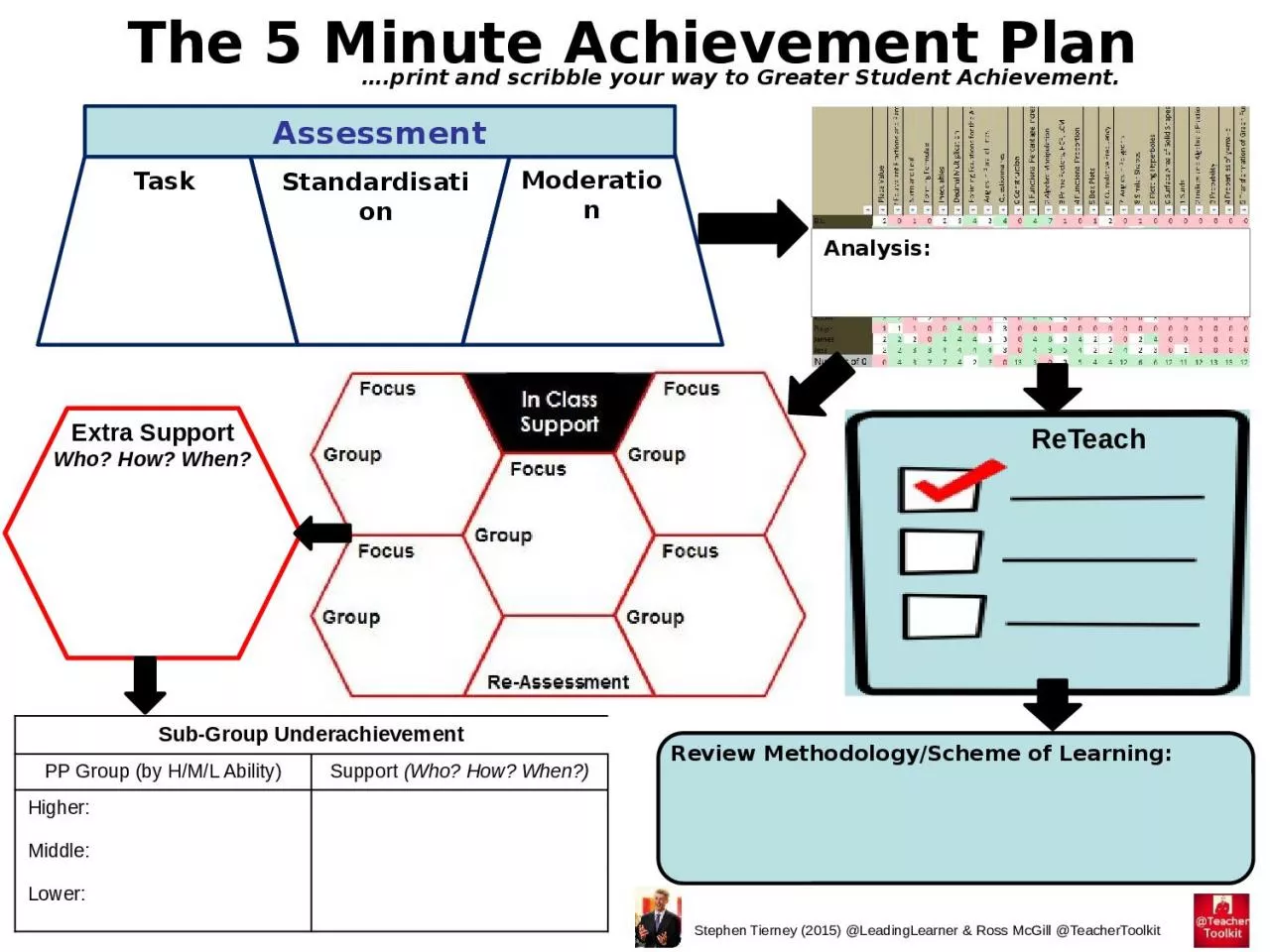

LeadingLearner amp Ross McGill TeacherToolkit The 5 Minute Achievement Plan print and scribble your way to G reater Student Achievement Assessment Task Standardisation Moderation Analysis ID: 1029566
Download Presentation The PPT/PDF document "Stephen Tierney (2015)" is the property of its rightful owner. Permission is granted to download and print the materials on this web site for personal, non-commercial use only, and to display it on your personal computer provided you do not modify the materials and that you retain all copyright notices contained in the materials. By downloading content from our website, you accept the terms of this agreement.
1. Stephen Tierney (2015) @LeadingLearner & Ross McGill @TeacherToolkit The 5 Minute Achievement Plan….print and scribble your way to Greater Student Achievement.AssessmentTaskStandardisationModerationAnalysis:ReTeachReview Methodology/Scheme of Learning:Extra SupportWho? How? When?Sub-Group UnderachievementPP Group (by H/M/L Ability)Support (Who? How? When?)Higher:Middle:Lower:
2. Context – (What each area means?)AssessmentWhen setting up an assessment for your class it is important to make sure you are clear about the actually examination paper, test or task to be done and have ways of standardising and moderating the marking of the students’ responses. The first job it to determine the actual assessment task. Approaching the SATs and examination season many teachers use full examination papers for their classes to practice on. If you are going to use the assessment to report a grade or levels remember to use: papers from the same year; all the different components of the final examination in your calculation of the grade or level and the SAT papers/examination board published grade boundaries.Standardisation of the marking between teachers can be done with the aid of a published or self-generated marking scheme. If you have any examiners in the department or school they can help with this process.Moderation of the marking can be achieved in different ways. Sometimes one teacher marks the whole of one paper or question. This removes inter-marker variability but class teachers miss the opportunity to see how their own students performed. If a number of teachers are marking the papers a sample needs to be moderated by all the teachers or a sample collected from each teacher and the marking moderated by the head of department or subject co-ordinator. AnalysisBefore you finalise the assessment you are going to use think about how you will analyse the papers or task, to evidence what the students know and what they don’t know. Many schools are beginning to look at a forensic question by question analysis of summative assessments. Where your subject has fewer longer answers or multi-part questions it can help if the students’ responses are analysed at this level. Be clear, in your own mind and with other staff, how you will analyse the assessment task and the recording expected. If marks are entered into a spreadsheet determine a total for each student’s response and a mean for the response to each question.ReTeachOnce the analysis has been completed look at which questions have a very low mean (average) score. It is likely that a lot of the children or student have not understood or can’t remember this particular aspect of knowledge. Note these down and reteach them to the whole class.
3. Context – (What each area means?)Review Methodology/Scheme of LearningWhere you consider there is a level of misunderstanding it is important to review how you intend to approach the re-teaching of the knowledge. It will probably be worth discussing this as a team or with another teacher whose class attained high marks on the particular question. Make a note of these different approaches and revise schemes of learning so they contain the most effective strategies for teaching the area of knowledge.In Class SupportThis requires some significant planning as members of the class may have different gaps in their knowledge. The challenge is to teach to each child or student’s gaps in knowledge.One potential strategy is when marking the assessments to use the Yellow Box Marking Technique to identify areas of the examination paper which must be improved to a higher standard. The In Class Support then consists of DIRT or MAD Time with each student working on their identified areas for improvement.Another approach is to group students by which questions they got wrong and need to revisit. Differentiated tasks or being directed to the appropriate section of an on-line resource can be used with the class teacher circulating and supporting as necessary. This could include short inputs, from the teacher, for each group. The groupings are quite dynamic as they reform once the student has acquired the missing knowledge. If classes are blocked on the timetable, it may be possible to rearrange these classes for a lesson or two with each new class focussing on a particular area or set of questions from the examination paper.Make sure you determine how you are going to reassess whether the students have acquired the knowledge that was previously missing.Extra SupportNote down the names of any students who are going to require additional more extensive support. This might be in extra after school sessions or through a planned intervention programme, with withdrawal from lessons,Sub-Group Underachievement - PP Group (by HML Ability)We’ve decided to focus on the Pupil Premium group as these are the students who are statistically most likely to be underachieving. If this is not appropriate for your class you should amend the table to look at the sub-group which requires greatest attention. Looking at Pupil Premium students through the lens of higher, middle and lower ability can sometimes yield an interesting pattern. Note down who, how and when intervention or support could take place.